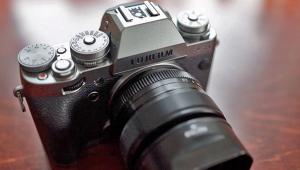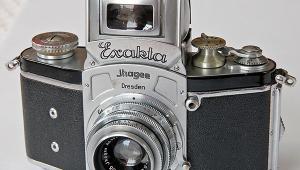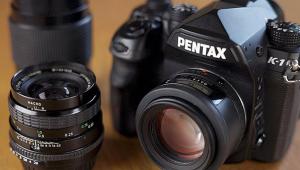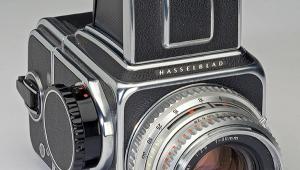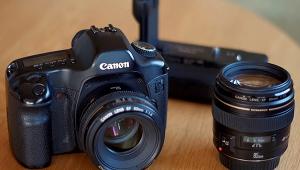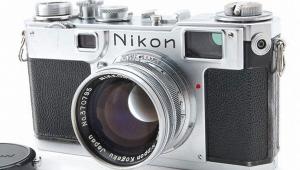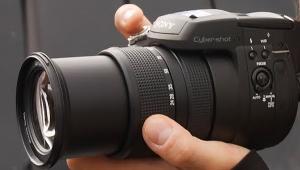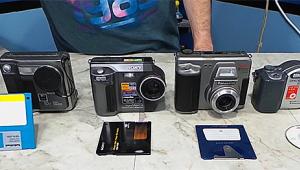It’s Instant—But It’s Not Polaroid: Pre- And Post-Polaroids, From 1864 To 1976
Polaroid was not the first company to try instant photography. Back in the daguerreotype and wet plate days, patents were granted for cameras in which the plate could be developed inside the body. But it wasn’t until 1864 that the first commercially successful instant picture camera came to the market.
Dubroni
The Dubroni was made in France and used the wet plate process. A photographic plate was loaded into a glass or ceramic container inside the camera. A pipette introduced silver nitrate onto the surface of the plate, via a hole in the top of the box-shaped body. The camera was tilted to allow the chemical to flow across the surface, and excess liquid was sucked out by the pipette and a rubber bulb.
After exposure, development was carried out by pouring in, and sucking out, chemicals through the same hole in the top of the camera. Development was by inspection through a ruby glass window in the back door of the body.

© Jeff Gould
Street Cameras
It made financial sense for street photographers to have an instant picture to sell to their subjects quickly after exposure. So during the late 19th century, and well into the 20th century, instant picture street cameras became popular.
The English Aptus was one of the best, made first for the ferrotype process as early as 1895. Plates were held in the base of the camera, from where they were lifted through 90˚ to the shooting position by a swiveling arm inside the camera attached to a lever outside. On the end of the arm a rubber sucker was linked by a tube to an external rubber bulb. Air sucked in by the bulb created a vacuum that held the plate in place on the sucker.

© John Wade
When the picture had been taken, the bulb was pressed, releasing the plate to fall into a tank below, containing a one-shot developing and fixing solution. The developed ferrotype plates were removed from the tank with a magnet.
In 1913, the Chicago Ferrotype Company produced the Mandelette, a small, wooden box-shaped street camera with a cloth sleeve protruding from the back and a developing tank below. It took postcard-size pictures on direct positive paper. The paper was placed into position for exposure and then dropped into the developing tank by the photographer, placing an arm through the sleeve and into the back of the camera.

© John Wade
The Jano While-U-Wait camera, made by M. Janovitch in the UK, also used a light-tight sleeve for the photographer to gain access to inside the camera body, where there were two trays to hold developer and fixer. Development was viewed through a red window on the top of the camera.

© John Wade
Maton
The Maton, introduced in 1930 by the French Multipurpose Portable Cameras Company, took 24 exposures 24x30mm. Inside, a prism reflected the image from the lens onto positive paper-backed film in square cassettes and running from one to the other along the base of the body. A crank on the side advanced the film and fired the shutter as it was turned, so pictures could be taken quickly in sequence—24 in 12 seconds, if the maker’s claims were to be believed.
After exposure, the cassette of film was removed and placed in a special holder which, in daylight, was passed through four processing solutions. The result was a strip of sepia-toned positives, produced in around 10 minutes.

© John Wade
Speed-O-Matic
The Speed-O-Matic was a Bakelite camera that took pictures on direct positive paper, sold two sheets at a time in a light-tight holder. The holder was slotted into one end of the camera and a lever was pulled to extract the paper and place it into position for shooting. A built-in extinction meter supplied a number that was set on a dial beneath the lens to adjust the aperture, the shutter was released and the paper pushed back into its holder.
The holder was then fitted onto a sleeve, which was attached to a developing tank, and another lever was used to pull the paper from the sleeve into the tank. Four developing solutions were poured in and out of the tank via a tiny funnel at the end of a rubber tube, after which the sleeve was removed and the developed picture extracted.

© John Wade
Moment
In 1952, the Russian GOMZ factory introduced a copy of Polaroid’s first instant picture camera. Like that one, the Moment used an upright folding bed design with a body covered in brown leather, although the lens panel differed from Polaroid’s design, as did the addition of a waist-level viewfinder.
Twin rolls of sensitized paper, connected by a paper leader, were dropped into opposite ends of the body with the paper leader threaded between two rollers and out of the camera. After exposure, as the leader was pulled, the exposed paper negative from one spool and the sensitized printing paper from the other came into contact, sandwiched between rollers.
Pods of chemicals on the paper negative burst under pressure from the rollers, spreading the solution between the two layers. The negative image developed first, then the unused silver salts were converted to a soluble solution by the chemistry from the pods and diffused through to the print paper, thus producing a positive image.
Unfortunately, the Russians failed to make the film work as successfully as Polaroid had before them, and few of these cameras have ever been used.

© John Wade
Kookie
The Kookie was made by the American Ideal Toy Company in 1968 to take 1 3/4” square direct positive images on special paper film.
The camera stood at the top of what appeared to be a complicated pattern of pipes. Protruding from the side was an arm and a hand, holding a flash gun that accepted flashcubes. Beneath that, another arm and hand held a tray with a tin of tomato soup on it. The so-called soup can was actually a lens hood, and the lens was an anamorphic to purposely distort the images.
As each picture was taken, a cutter was operated and the paper fell into a developing tank below the body, in which a one-shot solution produced direct positive pictures. A built-in egg timer was used for timing development.

© John Wade
Kodak EK2
In 1976, Kodak introduced its PR-10 instant picture system. It differed from Polaroid’s process in the way the image was exposed through the back of the print. The process was reversal, rather than a negative/positive one, and relied on dyes being released in proportion to the exposure.
The EK2 was one of the first Kodak instant picture cameras, launched in 1977. Its nickname was The Handle, since it used one to wind the film out of the camera and through rollers which were part of the development process.

© John Wade
Unfortunately, although the process was different from Polaroid’s, it was similar enough for Polaroid to go to law over patent infringement. The case battled its way through the courts until 1985 when judgment was made against Kodak, who then withdrew all their instant picture cameras.
- Log in or register to post comments
